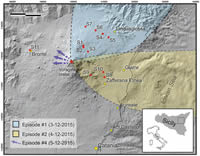Magma dynamics within a basaltic conduit revealed by textural and compositional features of erupted ash: the December 2015 Mt. Etna paroxysms
Pompilio M., A. Bertagnini, P. Del Carlo, A. Di Roberto (2017).
Nature, Scientific Reports 7, Article number: 4805, doi:10.1038/s41598-017-05065-x.
Abstract – introduction
In December 2015, four violent explosive episodes from Mt. Etna’s oldest summit crater, the Voragine, produced eruptive columns extending up to 15 km a.s.l. and significant fallout of tephra up to a hundred km from the vent.
A combined textural and compositional study was carried out on pyroclasts from three of the four tephra deposits sampled on the volcano at 6 to 14 km from the crater. Ash fractions (Φ=1-2) were investigated because these grain sizes preserve the magma properties unmodified by post-emplacement processes. Results were used to identify processes occurring in the conduit during each single paroxysm and to understand how they evolve throughout the eruptive period.
In particular we evidenced that in the studied paroxysms there is always the contemporaneous occurrence within the conduit of a high viscosity portion with a variable content of microlite and a less viscous volume of microlite-free, gas-rich magma.
During each single episode these heterogeneities can develop in few tens of hours. The time scale for the total refilling of the system and the renewal of magma is in the same order of magnitude (e.g. 30 hours between episode 1 and 2).
The composition of these magma batches changes in time and becomes progressively more evolved, as deeper crystallizing storage of magma are tapped. This behaviour, though not unusual in Mt. Etna’s shallow plumbing system, is markedly different from those proposed for some recent summit explosive activity on the basis of bulk chemistry.
Our analysis also confirms that the amount and shape of microlites, together with melt composition, have a strong control on rheological properties.
On this basis, we suggest that the transition between weak intracrater Strombolian activity and paroxysmal phases with km-high sustained columns, could be related to relative proportions within the conduit between high (microlite-rich) and low (microlite poor-gas rich) viscosity portions.
As shown in previous explosive eruptions of Mt. Etna, the ratio between these two components control fragmentation style and plume height. The prevalence of a crystalline volume favours brittle fragmentation and higher column heights. Nevertheless, the gas-rich microlite-free magma batches play an essential role because propel the explosive eruptions.
This work confirms that ash studies represent a powerful tool for unravelling the details of eruption dynamics. Combined textural and compositional investigations of ash, whose time of the eruption is well known, are crucial in this respect. Our results also indicate that compositional information from a single ash component can be misleading and that all components should be analysed in order to gain detailed information on magmatic columns and the development of eruptive processes. We also wish to stress that bulk chemistry, traditionally employed for petrological monitoring, may not be very informative in the analysis of such phenomena.
Galleria fotografica
https://www.flickr.com/photos/ingvpisa/albums/72157660212848064/with/23468713559/


